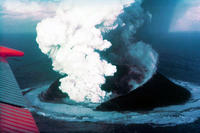You are in: Europe -> Iceland -> Surtsey, and traditional search or Image Gallery will yield results of this site only
Surtsey
| Site number: | 1267 |
|
| Type of site: | Natural | |
| Date: | 1963 to 1967 | |
| Date of Inscription: | 2008 | |
| Location: | Europe, Iceland, 32 km from the south coast of Iceland | |
Up to 75 images are shown here. Click on each for more details or on Image Gallery for more images.
Six official UN languages:
Arabic,
Chinese,
English,
French,
Russian,
Spanish
Other languages: Bulgarian, Czech, Danish, Dutch, Esperanto, Finnish, Galician, Hebrew, Hungarian, Icelandic, Italian, Japanese, Latvian, Norwegian-bokmål, Polish, Portuguese, Swedish, Turkish, Ukrainian
Other languages: Bulgarian, Czech, Danish, Dutch, Esperanto, Finnish, Galician, Hebrew, Hungarian, Icelandic, Italian, Japanese, Latvian, Norwegian-bokmål, Polish, Portuguese, Swedish, Turkish, Ukrainian
| Description: | Surtsey is a relatively new island formed by volcanic eruptions of 1963-1967; it is located approximately 32 km from the south coast of Iceland. Its uniqueness lies in the fact that it was protected from its birth, as a result presenting the world with an immaculate natural laboratory. Unexposed to human interference, Surtsey has supplied unique long-term information on the process of new land colonisation by plant and animal life. Since the study of the island began in 1964, scientists have observed ocean currents carrying in seeds, the appearance of moulds, bacteria and fungi; in 1965 the first vascular plant followed suit. By the end of the first decade the amount of vascular plants totaled 10 species, by 2004, they numbered 60 together with 75 bryophytes, 71 lichens and 24 fungi. Currently eighty-nine species of birds have been documented on Surtsey, 57 of which procreate elsewhere in Iceland. The 141 ha island also houses 335 species of invertebrates. --WHMNet paraphrase from the description at WHC Site, where additional information is available. | |
| Surtsey (Icelandic: "Surtur's island") is a volcanic island off the southern coast of Iceland. It is also the southernmost point of Iceland. It was formed in a volcanic eruption which began 130 metres (426 ft) below sea level, and reached the surface on 14 November 1963. The eruption may have started a few days earlier and lasted until 5 June 1967, when the island reached its maximum size of 2.7 km² (1.0 mi²). Since then, wind and wave erosion has caused the island to steadily diminish in size: as of 2002, its surface area was 1.4 km² (0.54 mi²). The new island was named after the fire god Surtr from Norse mythology, and was intensively studied by volcanologists during its creation and, since the end of the eruption, has been of great interest to botanists and biologists as life has gradually colonised the originally barren island. The undersea vents that produced Surtsey are part of the Vestmannaeyjar (Westmann Isles) submarine volcanic system, part of the fissure of the sea floor called the Mid-Atlantic Ridge. Vestmannaeyjar also produced the famous eruption of Eldfell on the island of Heimaey in 1973. The eruption that created Surtsey also created a few other small islands along this volcanic chain, such as Jólnir and other unnamed peaks. Most of these eroded away fairly quickly. --Wikipedia. Text is available under the Creative Commons Attribution-ShareAlike License. | ||
| Source: | http://whc.unesco.org/en/list/1267 | |
| Reference: | 1. UNESCO World Heritage Center, Site Page. | |














